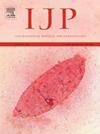茂密的水生植被可以减少寄生虫对两栖动物的传播。
IF 3.2
2区 医学
Q1 PARASITOLOGY
引用次数: 0
摘要
沉水植物(大型水生植物)可为猎物提供躲避捕食者的场所,在与寄生虫等其他天敌的互动中也可发挥类似作用。这可能是通过干扰自由游动的传染性寄生虫阶段的定位或向宿主移动的能力,从而减少感染。另一种情况是,如果巨藻减少了宿主的反寄生虫行为(如发现或逃避),感染率可能会增加。这两种情况都可能受到大型底栖生物密度和结构复杂性的影响。在此,我们研究了寄生扁形蠕虫(Ribeiroia ondatrae 和 Echinostoma spp.)对蝌蚪(Rana sylvatica 和 Rana pipiens)的实验感染是否会受到不同密度和复杂程度(简单与分支)的人工植被的影响,以及蝌蚪在这些条件下的活动。只有在密度最高的处理中,植被才会明显减少蝌蚪的感染量,但结构的复杂程度没有影响。与此相关的是,当水生植被密集时,蝌蚪在水生植被附近逗留的时间明显更长,但对两种结构类型都没有表现出偏好。我们的研究结果表明,在某些情况下,水生植被可以减少寄生虫的传播,考虑到富营养化和引入入侵植物物种可能带来的巨大物理变化,还需要进一步研究来探讨自然系统中的结构复杂性如何影响宿主与寄生虫之间的相互作用。本文章由计算机程序翻译,如有差异,请以英文原文为准。

Dense aquatic vegetation can reduce parasite transmission to amphibians
Submerged aquatic vegetation (macrophytes) can provide prey with refuges from predators and may perform a similar role for interactions with other natural enemies such as parasites. This could occur by interfering with the ability of free-swimming infectious parasite stages to locate or move towards hosts, reducing infections. Alternatively, infections may increase if macrophytes reduce host anti-parasite behaviours such as detection or evasion. Both scenarios could be affected by macrophyte density and structural complexity. Here we investigated whether experimental infection of tadpoles (Rana sylvatica and Rana pipiens) by parasitic flatworms (the trematodes Ribeiroia ondatrae and Echinostoma spp. was affected by the presence of artificial vegetation with varying density and complexity (simple versus branching), as well as tadpole activity under these conditions. Macrophyte presence significantly reduced tadpole infection loads only in the highest density treatment, but there was no effect of structural complexity. Related to this, tadpoles spent significantly more time near aquatic vegetation when it was dense but showed no preference for either structural type. Our results indicate that aquatic vegetation can reduce parasite transmission in certain scenarios, with further studies needed to explore how structural complexity in natural systems can affect host-parasite interactions, considering the massive physical alterations possible through eutrophication and the introduction of invasive plant species.
求助全文
通过发布文献求助,成功后即可免费获取论文全文。
去求助
来源期刊
CiteScore
8.40
自引率
2.50%
发文量
76
审稿时长
23 days
期刊介绍:
International Journal for Parasitology offers authors the option to sponsor nonsubscriber access to their articles on Elsevier electronic publishing platforms. For more information please view our Sponsored Articles page. The International Journal for Parasitology publishes the results of original research in all aspects of basic and applied parasitology, including all the fields covered by its Specialist Editors, and ranging from parasites and host-parasite relationships of intrinsic biological interest to those of social and economic importance in human and veterinary medicine and agriculture.

 求助内容:
求助内容: 应助结果提醒方式:
应助结果提醒方式:


